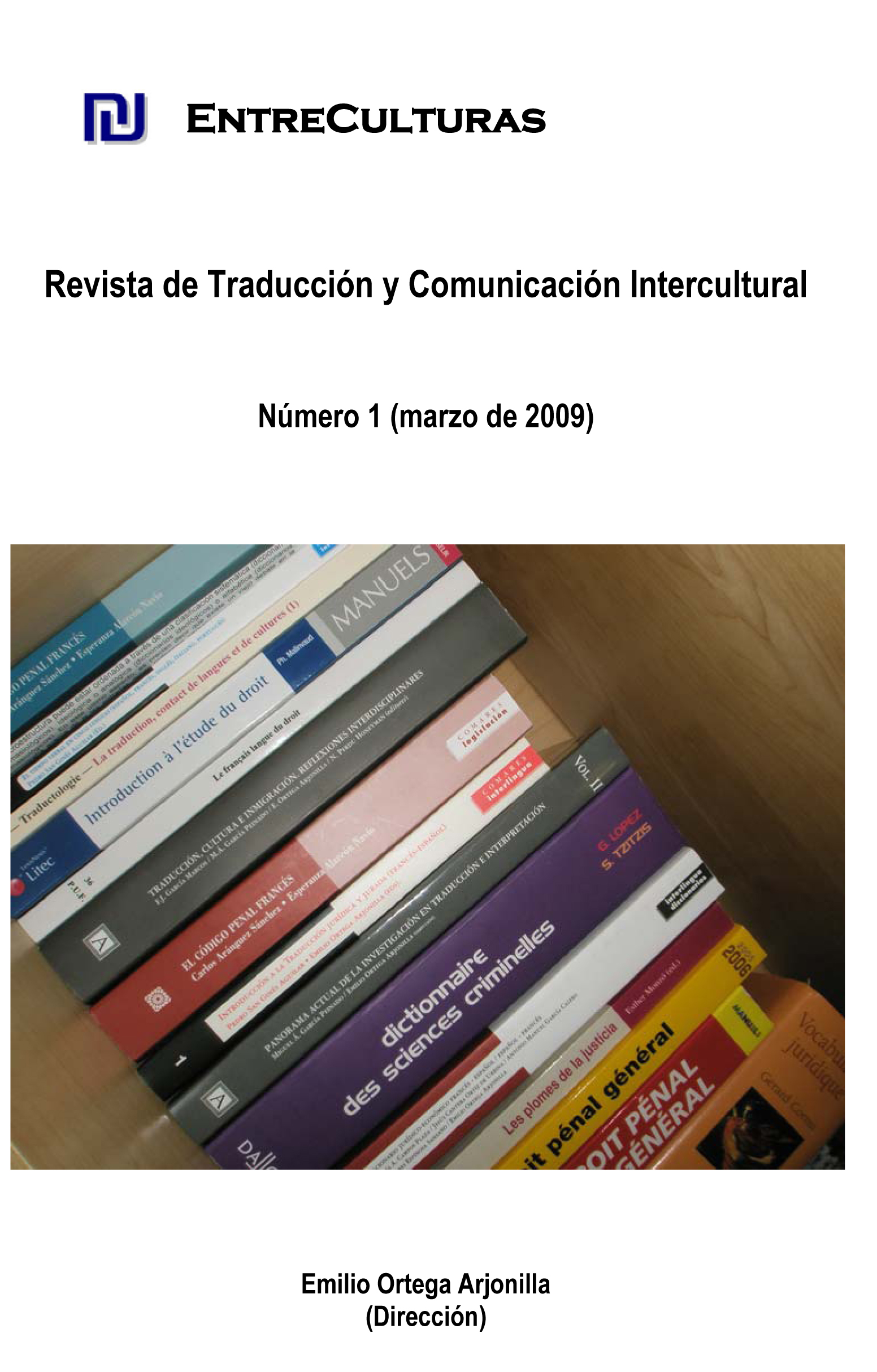TENDENCIAS ACTUALES EN LA TRADUCCIÓN DE TÍTULOS DE OBRAS DE ARTE PLÁSTICO
DOI:
https://doi.org/10.24310/Entreculturasertci.vi1.11872Keywords:
student, translation, interpretation, expectations, needsAbstract
This article aims to present certain conclusions on a very specific group, as is the profile of students wishing to study Translation and Interpretation. Therefore, the aim is to make an initial outline of the expectations and motivations of future Translation and Interpretation candidate students, by trying to identify their needs, fears, false conceptions and expectations.
Downloads
Metrics
References
CUÉLLAR LÁZARO, C (2004): “Estado actual de la investigación en Traducción Onomástica”. En Puntoycoma: Boletín de los traductores españoles de las instituciones de la Unión Europea, nº 89.
ECO, U (1971): Tratado general de semiótica. Barcelona: Lumen.
FRANCO AIXELÁ, J. (2000): La traducción condicionada de los nombres propios (inglésespañol). Análisis descriptivo. Salamanca: Ediciones Almar.
GARCÍA TORRES, M.A: “Comunicación visual”. En el sitio web de la empresa Image&Art. Dirección de Internet: http://www.imageandart.com/tutoriales/teoria/comunicacion_visual/index.html
GOYES NARVÁEZ, J.C. (2002): “Horizontes de la comunicación visual contemporánea”. En Espéculo, Revista de estudios literarios. Facultad de Ciencias de la Información de la Complutense de Madrid, nº 22. Disponible en Internet: http://www.ucm.es/info/especulo/numero22/com_visu.html
JIMÉNEZ SERRANO, O. (1996): “Breves notas sobre la traducción al español de los títulos de largometrajes”. En L. Félix Fernández, E. Ortega Arjonilla (coord.): Estudios sobre Traducción e Interpretación. Actas de las I Jornadas Internacionales de Traducción e Interpretación de la Universidad de Málaga.
MAYORAL ASENSIO, R., D. KELLY Y N. GALLARDO (1986): “Concepto de `traducción subordinada´ (cómic, cine, canción, publicidad). Perspectivas no lingu?ísticas de la traducción”. En Pasado, presente y futuro de la lingu?ística aplicada: actas del III Congreso Nacional de lingu?ística aplicada. Universidad de Valencia, pp.95-105.
MOYA, V. (2000): La traducción de los nombres propios, Madrid: Cátedra.
MUNARI BRUNO (1985): Diseño y comunicación visual. Barcelona: CG Diseño.
NUEZ SANTANA, J.L. (2001): Arte y minorías en los EEUU: el ejemplo chicano. Madrid: Instituto Universitario Agustín Millares de Documentación y gestión Informática.
ORTEGA ARJONILLA, E. (2006): “La Traducción del arte: una operación de mediación intercultural “estéticamente” condicionada”. En Hikma: Estudios de Traducción-Translation Studies, nº 5, pp. 179-199.
---- (2007): “Filosofía, Traducción y Cultura Visual. Un acercamiento intersemiótico a la comunicación intercultural”. En Coloquio: Fotografía y cuerpos políticos. Representaciones del cuerpo en la imagen contemporánea. Granada: Instituto de la Paz y Los Conflictos. 25-26 de octubre.
---- (editor) (2007): El giro cultural de la traducción: reflexiones teóricas y aplicaciones didácticas. Frankfurt: Peter Lang.
RODRÍGUEZ BOLUFÉ, O (2005): “Tras el hilo de Ariadna: reflexiones en torno al arte chicano”. En Nuestra Comunidad, revista semanal de la Universidad Iberoamericana de Ciudad de México, nº 159. Disponible en Internet: http://www.uia.mx/actividades/nuestracom/05/nc159/12.html.
VIDAL CLARAMONTE, A. (2003): “(Mis)Translating Degree Zero. Ideology and Conceptual Art”. En M. Calzada Pérez (Ed.): Apropos of Ideology. Manchester: St Jerome, pp 71-87.
VIDAL AULADELL, F. (2002): “Arte posmoderno y emancipación”. En A Parte Rei. Revista de Filosofía, nº 23. Disponible en Internet: http://serbal.pntic.mec.es/~cmunoz11/posmoderno.pdf.
VILLENA ÁLVAREZ, I. (2000): Problemática teórico-práctica de la traducción subordinada de cómics. Análisis de un caso práctico: La colección de historietas de Astérix en francés y en español. Málaga: Universidad de Málaga, pp 34-109.
Downloads
Published
How to Cite
Issue
Section
License
All contents published in Entre culturas. Revista de traducción y comunicación intercultural are protected under the Creative Commons Attribution-NonCommercial-ShareAlike 4.0 International (CC BY-NC-SA 4.0) license. All about this license is available in the following link: <http://creativecommons.org/licenses/by-nc-sa/4.0>
Users can copy, use, redistribute, share and exhibit publicly as long as:
- The original source and authorship of the material are cited (Journal, Publisher and URL of the work).
- It is not used for comercial purposes.
- The existence of the license and its especifications are mentioned.
There are two sets of authors’ rights: moral and property rights. Moral rights are perpetual prerogatives, unrenounceable, not-transferable, unalienable, imprescriptible and inembargable. According to authors’ rights legislation, Entreculturas. Revista de traducción y comunicación intercultural recognizes and respects authors moral rights, as well as the ownership of property rights, which will be transferred to University of Malaga in open access. The property rights are referred to the benefits that are gained by the use or the dissemination of works. Entreculturas. Revista de traducción y comunicación intercultural is published in an open access form and it is exclusively licenced by any means for doing or authorising distribution, dissemination, reproduction, , adaptation, translation or arrangement of works.
Authors are responsable for obtaining the necessary permission to use copyrighted images.





7.png)
